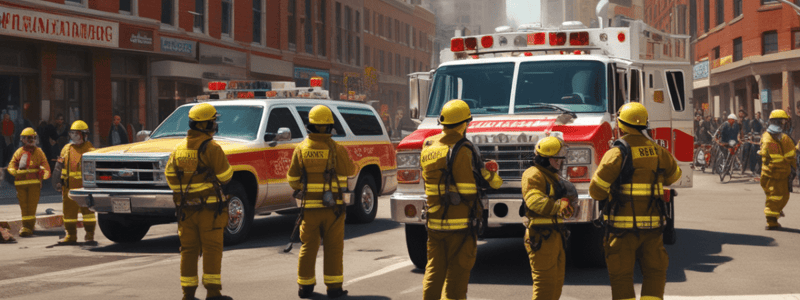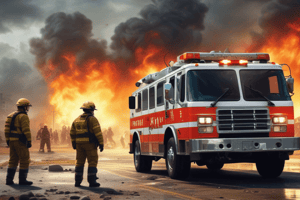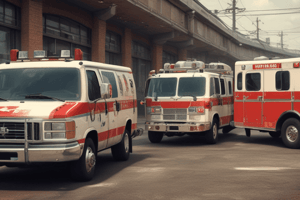Podcast
Questions and Answers
What is the primary responsibility of the first-arriving company officer at the scene of a multi-patient or mass casualty incident?
What is the primary responsibility of the first-arriving company officer at the scene of a multi-patient or mass casualty incident?
- Call for additional resources
- Assess the number of patients
- Establish Command (correct)
- Provide medical treatment to the injured
What is the primary tactical objective of the Incident Commander at a multi-patient or mass casualty incident?
What is the primary tactical objective of the Incident Commander at a multi-patient or mass casualty incident?
- Ensure the functions of triage, extrication, treatment and transportation are established
- Provide for the safety, accountability and welfare of rescue personnel and victims
- Stabilize the incident and provide for life safety
- Remove endangered occupants and treat the injured (correct)
At what point does the initial Incident Commander relinquish Command?
At what point does the initial Incident Commander relinquish Command?
- When the first patient is transported to the hospital
- When the incident is stabilized and Command is terminated (correct)
- When additional resources arrive
- When the triage process is complete
What is the responsibility of the Incident Commander regarding the tactical objectives?
What is the responsibility of the Incident Commander regarding the tactical objectives?
What is the term for the process of sorting patients based on the severity of their injuries?
What is the term for the process of sorting patients based on the severity of their injuries?
What is the first action of the first arriving officer at a multiple-patient incident?
What is the first action of the first arriving officer at a multiple-patient incident?
What is the purpose of the Triage Report?
What is the purpose of the Triage Report?
What is the priority order for treating and transporting patients?
What is the priority order for treating and transporting patients?
What is the role of the Incident Commander?
What is the role of the Incident Commander?
What should be established early in a multiple-patient incident?
What should be established early in a multiple-patient incident?
What is the purpose of early sectorization?
What is the purpose of early sectorization?
What is the purpose of using colored salvage covers in a treatment area?
What is the purpose of using colored salvage covers in a treatment area?
What is the purpose of the Staging Sector?
What is the purpose of the Staging Sector?
What is the purpose of the Triage Sector?
What is the purpose of the Triage Sector?
When should Level II Staging be implemented?
When should Level II Staging be implemented?
What is the purpose of the 'Triage Report'?
What is the purpose of the 'Triage Report'?
Why should units be parked at a distance from the scene?
Why should units be parked at a distance from the scene?
What is the primary purpose of the Extrication Sector?
What is the primary purpose of the Extrication Sector?
What is the role of the Triage Sector in relation to the Assembly Area?
What is the role of the Triage Sector in relation to the Assembly Area?
What is the preferred approach to patient treatment in the Treatment Sector?
What is the preferred approach to patient treatment in the Treatment Sector?
What is the role of the Transportation Sector in relation to hospitals?
What is the role of the Transportation Sector in relation to hospitals?
What is the role of the LZ Sector in a mass casualty incident?
What is the role of the LZ Sector in a mass casualty incident?
What is the purpose of the Safety Sector in a mass casualty incident?
What is the purpose of the Safety Sector in a mass casualty incident?
What is the purpose of the Staging Sector in a mass casualty incident?
What is the purpose of the Staging Sector in a mass casualty incident?
What is the purpose of the Triage Sector?
What is the purpose of the Triage Sector?
In a multi-patient incident response, what is the typical sequence of resource commitment?
In a multi-patient incident response, what is the typical sequence of resource commitment?
In a multi-patient incident response, what is the purpose of the Level II Staging area?
In a multi-patient incident response, what is the purpose of the Level II Staging area?
What is the role of the LZ Sector?
What is the role of the LZ Sector?
Flashcards are hidden until you start studying
Study Notes
Phoenix Regional Standard Operating Procedures for EMS Responsibilities
Scope and Policy Statement
- Establishes a standard structure and guideline for Fire Department units at multi-patient/mass casualty incidents
- Integrates with the overall incident management system
- Applies to incidents with varying numbers of patients (multi-patient, mass casualty, disaster)
Definitions
- Multi-patient incident: fewer than 25 patients
- Mass casualty incident: 25-100 patients
- Disaster: more than 100 patients
Procedure
- First-arriving company officer establishes Command and assumes responsibility for tactical objectives
- Tactical objectives:
- Remove endangered occupants and treat the injured
- Stabilize the incident and provide for life safety
- Establish triage, extrication, treatment, and transportation functions
- Ensure safety, accountability, and welfare of rescue personnel and victims
- Conserve property
- Command is responsible for building a command structure to match the organizational needs of the incident
Triage and Patient Assessment
- Triage should be initiated early in the incident
- Patients should be treated and transported in priority order: IMMEDIATE, DELAYED, MINOR
- Triage Report should be radioed to Dispatch, including patient numbers and conditions
Arrival and Scene Size-up
- First-arriving company officer should:
- Give an on-scene report and assume Command
- Initiate triage
- Perform a rapid hazard assessment and establish a safe zone
- Call for additional resources
- Radio a Triage Report to Dispatch
Staging
- Additional resources should be requested using standard assignments and alarms
- Staging area should be established to keep the scene clear and maintain access
- Units should be assigned to sectors, and medical equipment should be stockpiled in the treatment area
Command Responsibilities
- Incident Commander (IC) is responsible for:
- Determining strategy and setting priorities
- Obtaining and assigning resources
- Communicating objectives to tactical units
- Initiating a Unified Command with other agencies
Basic Sectors
- Triage Sector: determines patient location, number, and condition; assigns and supervises triage teams
- Extrication Sector: determines patient location, number, and condition; assigns and supervises extrication teams
- Treatment Sector: determines patient treatment needs; assigns and supervises treatment teams
- Transportation Sector: obtains transportation modes; determines hospital availability; coordinates patient allocation with Treatment Sector
Additional Sectors
- Safety Sector: ensures scene safety and monitors hazards
- Medical Supply Sector: procures, delivers, and stockpiles medical supplies
- LZ Sector: coordinates helicopter operations and ensures safe landing zones
Branches
- Medical Branch: directs all medical-related sectors; ensures completion of medical objectives
- Transportation Branch: directs all transportation-related sectors; ensures completion of transportation objectives
Studying That Suits You
Use AI to generate personalized quizzes and flashcards to suit your learning preferences.




